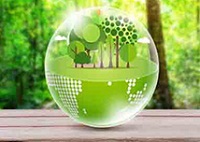"Every year, 100 million tons of new textiles come into the market and the textile industry has one of the highest turnovers in the world. It has long been understood that textile production has major environmental impact. But it has been difficult for textile companies to determine what choices they can make to reduce the environmental load, due to the wide variation in production processes."

Every year, 100 million tons of new textiles come into the market and the textile industry has one of the highest turnovers in the world. It has long been understood that textile production has major environmental impact. But it has been difficult for textile companies to determine what choices they can make to reduce the environmental load, due to the wide variation in production processes.

Researcher Sandra Roos has taken an overall approach to the clothing life cycle with her Swedish research reveals interesting facts doctoral thesis at Chalmers University of Technology in Sweden and the research institute Swerea, within the research program Mistra Future Fashion. Over the course of her five-year project, she studied 30 different sub-processes in textile production. She assessed toxicity of the chemicals used in the processes. The sub-processes studied extend from techniques as different as entirely synthetic textile fibres made of plastic, to cotton production – where farmers cultivate the soil, plant and harvest the cotton, before ginning and preparing it.
Collaborating for sustainability
Mistra Future Fashion is a collaborative project between the fashion industry and researchers in Sweden. Their next step will be to transform the results of the thesis to a practical tool that clothing manufacturers can use to improve the environmental performance of their processes and products. The tool is expected to be ready sometime in 2017. This is an important step, since the majority of the environmental load in the clothing life cycle is created in the production phase.
Roos's research shows conventional cotton growing, where large quantities of insecticides are spread directly on land, stands out as a particularly heavy burden on the environment. At present, most environmental indices are based on the type of textile fibre used: wool, nylon, polyester or cotton. But that is not where the major environmental impact is found, which is actually in the post-fibre processing stages: spinning, weaving, knitting and, above all, in the dyeing – the wet processing. All chemicals used in these processes actually make it hazardous as cotton growing.
Usability quotient
To be eco-friendly clothes need to be used until they are worn out. That is more important than all other aspects, such as how and where the clothes were manufactured and the materials they are made of. But in industrialised countries, only a tiny percentage of garments are worn 100 to 200 times, which is usually the potential lifetime. In Sweden, for example, consumers buy an average of 50 new garments per person in a year. It is difficult for consumers to get information about the most important aspects – those related to processing of the textile materials.
Textiles are made of cellulose from trees and plants are an important track in research and development to close the loop so that the textile industry becomes sustainable. Viscose, modal and lyocell/Tencel are examples of such textiles that are already available and whose environmental performance is often good.
Eco-labelled clothing
Buying eco-labelled clothes makes a difference. There are several cotton labels, including BCI (Better Cotton Initiative) and GOTS. However, eco-cotton labels only indicate that the cotton was organically grown – they say nothing about the rest of the production process (dyeing and treatment). On-line shopping is generally a very good alternative from the environmental perspective. But only if you do not end up buying clothes you like less – and hence wear less – or returning lots of garments. E-retailers do not always put returned garments back in stock to be sold again.












